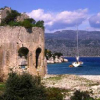
Demre was one of the most important cities of the Lycian civilisation. 25km west of Finike and 48km east of Kas, Demre was a place of settlement from the 5th century BC. The city was deserted in 9 A.D after the invasions of the Arabs. Rock tombs, theatres and the Church of St. Nicholas (said to be the original Santa Claus) are the most interesting sites in the town today.
Santa Claus
Saint Nicholas, known throughout the world as Santa Claus, was born in the ancient Lycian city of Patara, an important city on the Mediterranean coast of Turkey. Around 300 A.D., during a prosperous era for Patara, a rich wheat merchant had a son and named him Nicholas. His birth was accepted as a gift from the Heavens, the fruit of his parents' prayers and vows and a savior for the poor people. It is believed that he performed miracles even as a young man. According to one legend, Nicholas was trapped under the wreckage of an old church and he survived, while his mother was crying and calling out for him.
After the death of Nicholas' father, he inherited a large estate, which he decided to use to aid the poor. At around the same time, one of Patara's wealthiest men fell into poverty to such an extent that he lacked the means even to gather together dowries for his daughters. He felt so desperate that he even considered selling his daughters, when Nicholas decided to help them. One night he entered the their house, secretly, in order to remain anonymous and also to spare the family's honor.
While the family was asleep he dropped into the open window of the eldest daughter a bag of gold, enough to cover her dowry. In the morning, the daughter was overjoyed to the find the gold which would save her from this desperate situation.
Later, Nicholas also decided to help the two younger daughters, but since their windows were closed, he dropped the money for them in a bag from the chimney. This started the legend of Santa Claus distributing presents at Christmas time. This story also explains why he is depicted in pictures and iconographic representations bearing three balls made of gold.
Another story from St. Nicholas' life goes as follows:
Nicholas went on a pilgramage to Jerusalem. On his way back, he saved a ship from sinking. Miraculously, he also brought a drowned sailor back to life. From that time on, St. Nicholas has been known as the patron saint of sailors.
After some years, Nicholas left his home of Patara and moved to the nearby city of Myra. At that time, the bishop of Myra had passed away and no agreement could be reached on his successor. Finally, the town residents decided that the next person to enter the local church would become their next bishop. The first to enter was Nicholas, and so he took on the clerical calling. His miracles continued in Myra, including an incident in which he saved the lives of three generals. Another story goes as follows:
One year, Myra experienced a great famine. A fleet carrying corn from Alexandria to Byzantium stopped off at Myra's harbor of Andriake. Nicholas ran to the harbor and demanded that each ship give him a certain share of their corn. When the sailors returned to Byzantium, they were shocked to discover that all the corn that they had given, unwillingly was right back where they had left it.Like many Christians of his era, Nicholas was imprisoned for a time by the Emperors Diocletian and Licinius, on account of his faith. In 325, Nicholas participated in a council meeting held to settle a number of theological disputes within Christianity, in his capacity as the bishop of Myra. A churchman named Bonaventure claimed that on his way to the Council, Nicholas brought back to life three children who had been killed and were about to be eaten. Legend has it that Nicholas, who is also known as the patron saint of students, is believed to have passed away at the age of 65 on December 6, 343. The Myrians built a church to honor his sainthood and interred him in a sarcophagus as his final resting place.On April 20, 1087, during the First Crusade, some parts of his skeleton were stolen and taken away by merchants from Bari. The rest of his remains currently rest at the Antalya Museum.
 Demre was one of the most important cities of the Lycian civilisation. 25km west of Finike and 48km east of Kas, Demre was a place of settlement from the 5th century BC. The city was deserted in 9 A.D after the invasions of the Arabs. Rock tombs, theatres and the Church of St. Nicholas (said to be the original Santa Claus) are the most interesting sites in the town today.
Demre was one of the most important cities of the Lycian civilisation. 25km west of Finike and 48km east of Kas, Demre was a place of settlement from the 5th century BC. The city was deserted in 9 A.D after the invasions of the Arabs. Rock tombs, theatres and the Church of St. Nicholas (said to be the original Santa Claus) are the most interesting sites in the town today.